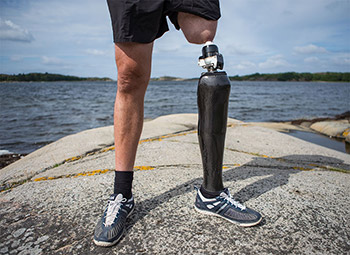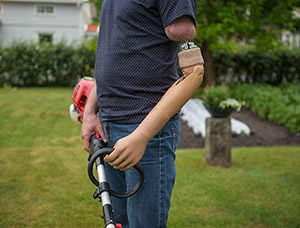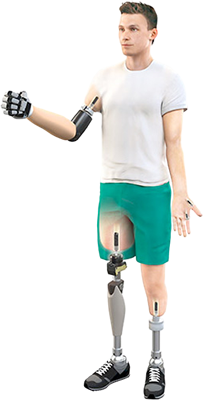What is Osseointegration? 
Osseointegration (OI), also known as direct skeletal fixation (DSF), is a surgical procedure that involves fitting a metal implant directly into the bone and allowing for a prosthesis to be connected to it. Surgery is performed in two stages, the first to establish osseointegration of the implant in the femoral canal. While the second stage allows creation of the the skin-implant interface to enable direct skeletal fixation. Osseointegration aims to provide improved mobility and function and quality of life to individuals who have undergone amputation.
Osseointegration represents a significant change from the traditional method of fitting a prosthetic socket to a residual limb, which has been the traditional approach for hundreds of years.
- We use the OPRA™ Osseointregration system.
- It is the only FDA approved system in the US.
- It has been used for over 20 years and implanted over 500 times.
- The implant design continues to be improved upon, based on this vast experience.
- Implant design mimics that of a dental implant, it is a screw-shaped titanium prosthesis that is secured to the femoral canal.
- After osseointegration of the implant in the femoral canal, then skin-implant interface is created and weight bearing begins.
The OPRA™ is the only FDA approved osseointegration system in the US
OPRA™ Postoperative Protocol
- Following surgery, dressings need to be changed every 2-3 days until proper healing has taken place
- Antibiotics are prescribed to prevent infection
- Sutures will usually be removed in 3 weeks
- A physical therapy program is recommended to help with mobilization and use of the limb
Who is a Good Candidate for Osseointegration?
You are a good candidate for osseointegration if you:
- Are uncomfortable with the use of conventional socket prostheses due to pain, skin problems, and perspiration
- Have difficulty with sitting, standing, or walking with the use of prosthetic socket
- Have fitting issues with the use of prosthetic sockets
- Have obtained full skeletal maturity
- Have normal skeletal anatomy
- Are between 18 years old and 70 years old
- Have met the criteria for surgery based on your medical history and physical examination
- Are willing to comply with the treatment recommendation and subsequent follow-up
Who is Not a Good Candidate for Osseointegration?
You are not a good candidate for osseointegration if you:
- Are diabetic
- Have severe peripheral vascular disease
- Are pregnant
- Have exposed your legs to radiation
- Have osteoporosis
- Are a smoker
- Have skin disorders involving the amputated leg
- Have mental illness or psychotic disorder
- Are satisfied with conventional prosthetic sockets
Benefits of Osseointegration
Some of the potential benefits of osseointegration include:
- Eliminates the need for prosthetic sockets
- Reduced pain or irritation experienced with prosthetic sockets
- Enhanced stability with standing or walking
- Able to walk long distances with enhanced sitting comfort
- Minimal skin complications
- Osseoperception - a more natural feeling with an ability to feel or sense the prosthesis
- Improved quality of life
Complications of Osseointegration
Some of the potential complications of osseointegration include:
- Skin irritation
- Muscle pain
- Skin infection
- Soft tissue impingement
- Periprosthetic fractures
- Failure of osseointegration, needing implant revision

